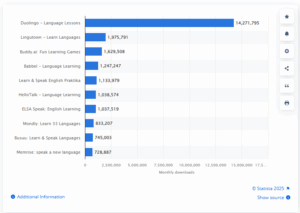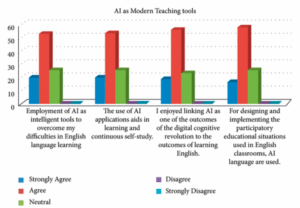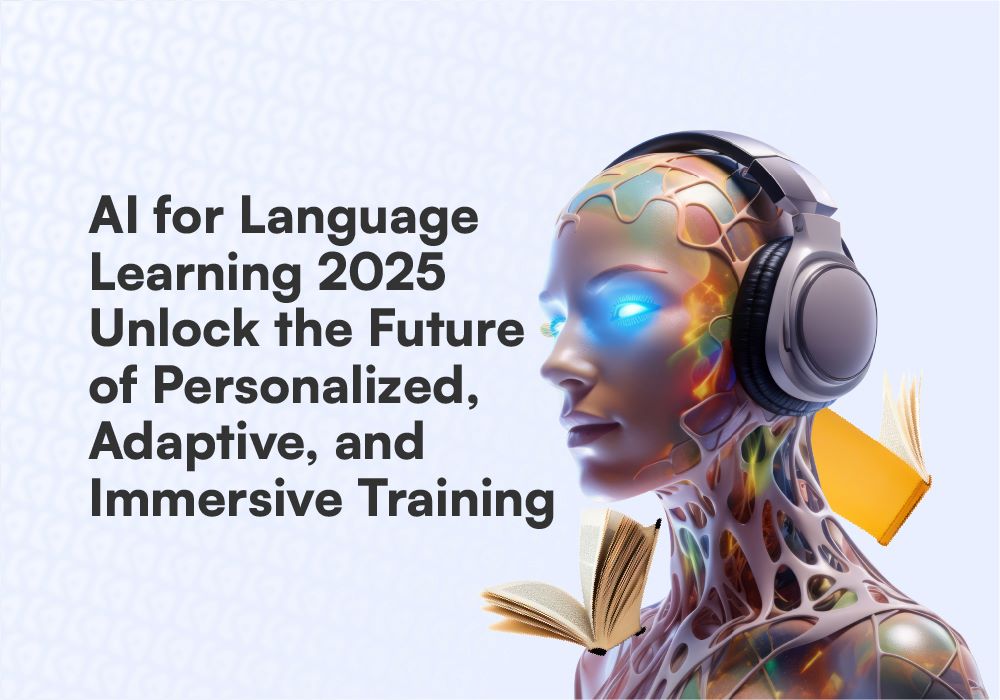Hvad er kunstig intelligens, og hvordan fungerer det i uddannelse?
AI (Kunstig intelligens) refererer til en gren af datalogi, der studerer menneskelige tænkemønstre og ikke kun digitalt replikerer dem, men også udvikler systemer, der handler på en tænke-lignende måde. I sin kerne beskriver AI computersystemer, der kan analysere deres omgivelser, udtrække relevant information og bruge den til at træffe beslutninger, der øger deres chancer for at nå specifikke mål.
Inden for uddannelse, især sprogindlæring, spiller AI til sprogindlæring en stadig større rolle. Derfor kan du drage fordel af AI-drevne værktøjer til at få udenlandske tekster læst højt, tjekke din skrivning for grammatik og indhold eller endda øve med virtuelle samtalepartnere.
Interesseret i AI og sociale medie-algoritmer? Læs dette: AI's rolle i algoritmer på sociale medier.
En af de mest kendte platforme er ChatGPT, en sprog-AI-model, der svarer med menneskelignende svar på inputs på naturligt sprog. Mange elever verden over bruger ChatGPT specifikt til AI til sprogindlæring for effektivt at forbedre deres færdigheder.
Førende sprogindlæringsapps verden over i juli 2024, efter downloads

Diagrammet med titlen “Verdens førende sprogindlæringsapps i juli 2024 efter antal downloads”, offentliggjort af Laura Ceci den 29. august 2024, baseret på data fra Statisca, viser at i juli 2024 var Duolingo den mest populære sprogindlæringsapp verden over. Cirka 14,3 millioner brugere downloadede appen på deres mobile enheder i løbet af måneden.
Lingutown var den næstmest populære sprogindlæringsapp i denne periode, med næsten to millioner downloads. Apps fokuseret på sprogindlæring for børn var også meget eftertragtede. Den børnespecifikke app Buddy.ai: Fun Learning Games havde 1,63 millioner downloads verden over. Sprogindlæringsapps, der kombinerer spil med sprogindlæring, bliver stadig mere populære blandt både voksne og børn som en sjov og effektiv måde at lære og øve et fremmedsprog på.

Søjlediagram med titlen “AI som moderne undervisningsværktøjer,” offentliggjort fra ResearchGate, viser undersøgelsesresultater om, hvordan AI støtter engelsklæring. De fleste deltagere var enige om, at AI hjælper selvstudium, hjælper med at overvinde læringsvanskeligheder og øger engagementet i klasseværelset.
Sprogindlæringsapps med AI-support
Nogle af de mest populære sprogindlæringsapps inkluderer:
- Duolingo: Denne app bruger AI i spilbaserede sammenhænge til at motivere og engagere sprogindlærere (gamification) og tilbyder personlige læringsforløb. Øvelserne drives af AI til sprogindlæring tilpas til elevens tempo.
- Babbel: AI muliggør adaptive læringsmetoder, der analyserer ikke kun fremskridt men også optimerer lektioner. Den fokuserer på autentiske samtaler og støtter elever specifikt i AI til sprogindlæring.
- Busuu: AI-drevne grammatik- og udtaleøvelser hjælper elever med at forbedre sig effektivt. Derudover kan elever få feedback fra native speakers, hvilket gør AI til sprogindlæring endnu mere effektiv.
- Lingvist: I denne sprogindlæringsapp fokuserer AI på ordforråd og personlig repetition. Lærere modtager målrettede ord baseret på deres færdighedsniveau, hvilket gør AI til sprogindlæring meget optimeret.
- Rosetta Stone: Denne platform bruger AI-algoritmer til at give eleverne personlig feedback og anbefalinger, hvilket sikrer at AI til sprogindlæring understøtter læringsprocessen på en individualiseret måde.
Fordele ved at bruge AI til sprogindlæring
Personalisering af læringsprocessen: Personalisering med AI til sprogindlæring betyder, at elever kan tilpasse deres læringsproces til deres egne karakteristika, behov og interesser, hvilket øger motivation, engagement, forståelse og præstation. Da det ikke er muligt i alle klasseværelser for lærere at imødekomme hver enkelt elevs behov, kommer AI til sprogindlæring i spil. Elever kan bruge specifikke prompts på enhver AI-platform, som f.eks. ChatGPT, til at lave ordforrådsøvelser, lektioner eller tekster, der er tilpasset deres niveau og læringsbehov.
Individuel tilpasning af læringsprocessen: Mange elever bruger AI til sprogindlæring for at fokusere på deres individuelle styrker og svagheder, fordi AI kan lave personlige læringsplaner. Ved at skabe materialer, der passer til deres niveau, kan eleverne sætte deres eget tempo og vælge emner, de er interesserede i, hvilket øger motivationen. AI-systemer analyserer elevernes ordforråd og sprogforståelse og justerer indholdet dynamisk efter deres fremskridt.
Tidsbesparende fejlretning og feedback: AI-værktøjer retter elevers fejl og giver øjeblikkelig feedback. Det sparer en masse tid i forhold til at bede lærere om at gøre det under timen, hvilket gør AI til sprogindlæring ekstremt effektivt.
Udfordringer ved AI til sprogindlæring
En af de største udfordringer ved AI til sprogindlæring er dataprivatliv. AI-værktøjer gemmer omfattende personlige oplysninger om lærendes adfærd og læringsvaner. Derfor skal lærende sikre, at de overholder lovkravene og håndterer data sikkert for at beskytte deres privatliv. En anden udfordring er den potentielle afhængighed af AI, hvor lærende måske har svært ved at lære uden det.
Fremtiden for AI til sprogindlæring
AI til sprogindlæring har potentialet til at skabe fordybende læringsmiljøer, der gør det muligt for elever at engagere sig fuldt ud i læringsprocessen. AI gør det muligt for elever at øve, som om de var i virkelige situationer, samtidig med at de får personlig vejledning og støtte.
I fremtiden kan AI blive integreret med Virtual Reality (VR) og Augmented Reality (AR) for at simulere ægte samtaler, kulturelle oplevelser, interaktive scenarier og interkulturel kommunikation, hvilket gør sprogtræning mere engagerende og realistisk. For eksempel kan elever deltage i et virtuelt marked i Tokyo for at øve japansk eller bestille mad i en simuleret café i Paris for at forbedre deres franske færdigheder.
Der er blandede forudsigelser om AI's fremtid, men et interessant perspektiv kommer fra Bill Gates, , som sagde i „New York Postden 27. marts 2025, vil AI erstatte læger, lærere inden for 10 år — og påstår, at mennesker ikke vil være nødvendige ‘til de fleste ting.’
Hvis det var sandt, kunne folk i fremtiden endda bruge AI til sprogindlæring for at lære nye sprog effektivt.
Konklusion
Med hjælp fra AI til sprogindlæring kan elever i dag gøre deres læringsproces mere effektiv, personlig og motiverende. Dette er en stor fordel ved AI til sprogindlæring.
Gennem personlige øvelser, adaptive læringsstier og automatiseret feedback kan AI til sprogindlæring specifikt tage højde for elevernes styrker og svagheder. Samtidig bør eleverne bruge AI ansvarligt, især med hensyn til dataprivatliv, datastyring og potentiel afhængighed. Selvom AI i fremtiden kan integrere immersive læringsmiljøer og teknologier som VR og AR, erstatter det ikke fuldt ud lærere. Det supplerer snarere traditionelle læringsmetoder og giver individuel støtte til sprogtræning.


